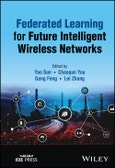Explore the concepts, algorithms, and applications underlying federated learning
In Federated Learning for Future Intelligent Wireless Networks, a team of distinguished researchers deliver a robust and insightful collection of resources covering the foundational concepts and algorithms powering federated learning, as well as explanations of how they can be used in wireless communication systems. The editors have included works that examine how communication resource provision affects federated learning performance, accuracy, convergence, scalability, and security and privacy.
Readers will explore a wide range of topics that show how federated learning algorithms, concepts, and design and optimization issues apply to wireless communications. Readers will also find: - A thorough introduction to the fundamental concepts and algorithms of federated learning, including horizontal, vertical, and hybrid FL - Comprehensive explorations of wireless communication network design and optimization for federated learning - Practical discussions of novel federated learning algorithms and frameworks for future wireless networks - Expansive case studies in edge intelligence, autonomous driving, IoT, MEC, blockchain, and content caching and distribution
Perfect for electrical and computer science engineers, researchers, professors, and postgraduate students with an interest in machine learning, Federated Learning for Future Intelligent Wireless Networks will also benefit regulators and institutional actors responsible for overseeing and making policy in the area of artificial intelligence.
Table of Contents
About the Editors xv
Preface xvii
1 Federated Learning with Unreliable Transmission in Mobile Edge Computing Systems 1
Chenyuan Feng, Daquan Feng, Zhongyuan Zhao, Howard H. Yang, and Tony Q. S. Quek
1.1 System Model 1
1.2 Problem Formulation 4
1.3 A Joint Optimization Algorithm 10
1.4 Simulation and Experiment Results 16
2 Federated Learning with non-IID data in Mobile Edge Computing Systems 23
Chenyuan Feng, Daquan Feng, Zhongyuan Zhao, Geyong Min, and Hancong Duan
2.1 System Model 23
2.2 Performance Analysis and Averaging Design 24
2.3 Data Sharing Scheme 30
2.4 Simulation Results 42
3 How Many Resources Are Needed to Support Wireless Edge Networks 49
Yi-Jing Liu, Gang Feng, Yao Sun, and Shuang Qin
3.1 Introduction 49
3.2 System Model 50
3.3 Wireless Bandwidth and Computing Resources Consumed for Supporting FL-EnabledWireless Edge Networks 54
3.4 The Relationship between FL Performance and Consumed Resources 59
3.5 Discussions of Three Cases 62
3.6 Numerical Results and Discussion 67
3.7 Conclusion 75
3.8 Proof of Corollary 3.2 76
3.9 Proof of Corollary 3.3 77
4 Device Association Based on Federated Deep Reinforcement Learning for Radio Access Network Slicing 85
Yi-Jing Liu, Gang Feng, Yao Sun, and Shuang Qin
4.1 Introduction 85
4.2 System Model 87
4.3 Problem Formulation 90
4.4 Hybrid Federated Deep Reinforcement Learning for Device Association 94
4.5 Numerical Results 103
4.6 Conclusion 109
5 Deep Federated Learning Based on Knowledge Distillation and Differential Privacy 113
Hui Lin, Feng Yu, and Xiaoding Wang
5.1 Introduction 113
5.2 RelatedWork 115
5.3 System Model 118
5.4 The Implementation Details of the Proposed Strategy 119
5.5 Performance Evaluation 120
5.6 Conclusions 122
6 Federated Learning-Based Beam Management in Dense Millimeter Wave Communication Systems 127
Qing Xue and Liu Yang
6.1 Introduction 127
6.2 System Model 130
6.3 Problem Formulation and Analysis 133
6.4 FL-Based Beam Management in UDmmN 135
6.6 Conclusions 150
7 Blockchain-Empowered Federated Learning Approach for An Intelligent and Reliable D2D Caching Scheme 155
Runze Cheng, Yao Sun, Yijing Liu, Le Xia, Daquan Feng, and Muhammad Imran
7.1 Introduction 155
7.2 RelatedWork 157
7.3 System Model 159
7.4 Problem Formulation and DRL-Based Model Training 160
7.5 Privacy-Preserved and Secure BDRFL Caching Scheme Design 165
7.6 Consensus Mechanism and Federated Learning Model Update 170
7.7 Simulation Results and Discussions 173
7.8 Conclusion 177
8 Heterogeneity-Aware Dynamic Scheduling for Federated Edge Learning 181
Kun Guo, Zihan Chen, Howard H. Yang, and Tony Q. S. Quek
8.1 Introduction 181
8.2 RelatedWorks 184
8.3 System Model for FEEL 185
8.4 Heterogeneity-Aware Dynamic Scheduling Problem Formulation 189
8.5 Dynamic Scheduling Algorithm Design and Analysis 192
8.6 Evaluation Results 197
8.7 Conclusions 208
8.A.1 Proof of Theorem 8.2 208
8.A.2 Proof of Theorem 8.3 209
9 Robust Federated Learning with Real-World Noisy Data 215
Jingyi Xu, Zihan Chen, Tony Q. S. Quek, and Kai Fong Ernest Chong
9.1 Introduction 215
9.2 RelatedWork 217
9.3 FedCorr 219
9.4 Experiments 226
9.5 Further Remarks 232
10 Analog Over-the-Air Federated Learning: Design and Analysis 239
Howard H. Yang, Zihan Chen, and Tony Q. S. Quek
10.1 Introduction 239
10.2 System Model 241
10.3 Analog Over-the-Air Model Training 242
10.4 Convergence Analysis 245
10.5 Numerical Results 250
10.6 Conclusion 253
11 Federated Edge Learning for Massive MIMO CSI Feedback 257
Shi Jin, Yiming Cui, and Jiajia Guo
11.1 Introduction 257
11.2 System Model 259
11.3 FEEL for DL-Based CSI Feedback 260
11.4 Simulation Results 264
11.5 Conclusion 268
12 User-Centric Decentralized Federated Learning for Autoencoder-Based CSI Feedback 273
Shi Jin, Jiajia Guo, Yan Lv, and Yiming Cui
12.1 Autoencoder-Based CSI Feedback 273
12.2 User-Centric Online Training for AE-Based CSI Feedback 275
12.3 Multiuser Online Training Using Decentralized Federated Learning 279
12.4 Numerical Results 283
12.5 Conclusion 287
Bibliography 287
Index 291








